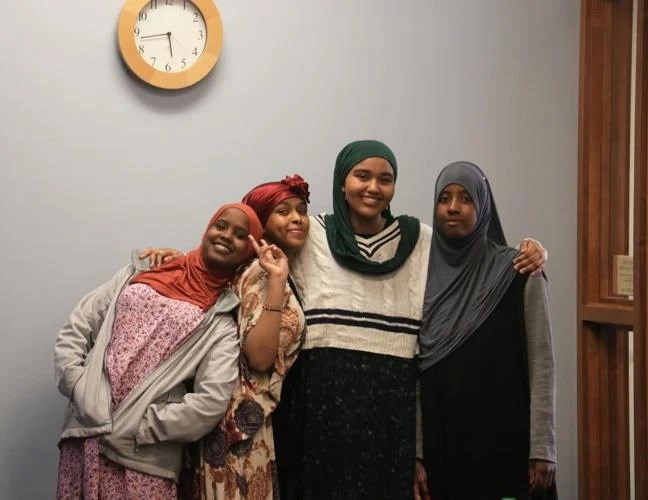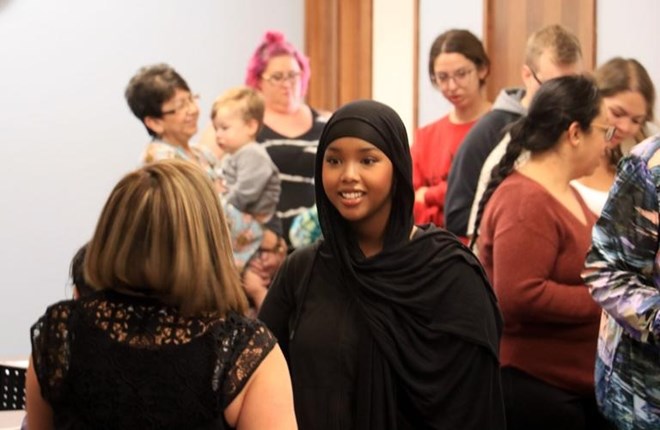
Wednesday April 26, 2023
By Brian Neben

The Lexington Public Library Family Fun Night was attended by over 30 people who had an opportunity to sample Somali food and learn ab out theirculture, traditions and celebrations. Brian Neben. Lexington Clipper-Herald
LEXINGTON — Somali culture was the focus on the Family Fun Night, hosted by the Lexington Public Library during the evening of Monday, April 24.
“For some time now I was interested in learning how I could attract more young people and parents from Somalia to the library and involve them in library activities,” Rossy Casanova, Youth and Family Services Librarian said.
Casanova said Umayma Abdi is a student at Lexington High School who has volunteered at the library during special events in the past. She asked Abdi if she would be willing to help organize an event related to her culture.
“She was excited and happy to help me,” Casanova said, “She invited her friends to be part of the planning and together with the library director Jennifer Norton, Shonna Werth and Scott Foster, both from Community 4 Kids, we began planning the event.”
The event was attended by over 30 people who had an opportunity to sample Somali food and learn about their culture, traditions and celebrations.
“We are all part of the same community and even though many times we do not share the same beliefs or have the same history. We are here because we want a better life, and that is what Lexington offers us: security, tranquility, harmony. We know that we can go out on the streets without fear of anything,” Casanova said.
“Even though we feel safe, we don't always feel welcome. I don't want that for the Lexington community. For the community I want everyone, regardless of religion, culture, history, or appearance to feel welcome. For all of us to work together for the prosperity and unity of Lexington, the place where many of us call it home,” said Casanova.
Somalia is a country in the Horn of Africa, bordered by Ethiopia to the west, the Gulf of Aden to the north, Indian Ocean to the east and Kenya to the southwest. It has the longest coastline on Africa’s mainland.
The country has an estimated population of around 17.1 million, of which over two million live in the capital and largest city Mogadishu.
Somali and Arabic are the official languages of Somalia. The Somali language is the mother tongue of the Somali people, the nation's most populous ethnic group.

"At the end, I was happy with the turnout of the program. The girls' spirit and enthusiasm for their culture and country was very contagious for everyone," Casanova said. Brian Neben. Lexington Clipper-Herald
Somali dialects are divided into three main groups: Northern, Benadir and Maay. Northern Somali (or Northern-Central Somali) forms the basis for Standard Somali. Benadir (also known as Coastal Somali) is spoken on the Benadir coast, from Adale to south of Merca including Mogadishu, as well as in the immediate hinterland.
Islam is the primary religion of the country, with 99.8 percent of the country adhering to the faith, according to the Pew Research Center. The majority belong to the Sunni branch of Islam.
Islam entered the region very early on, as a group of persecuted Muslims had sought refuge across the Red Sea in the Horn of Africa at the urging of the Islamic prophet Muhammad.
The cuisine of Somalia, which varies from region to region, is a mixture of diverse culinary influences. It is the product of Somalia's rich tradition of trade and commerce.
Despite the variety, there remains one thing that unites the various regional cuisines: all food is served halal. There are, therefore, no pork dishes, alcohol is not served, nothing that died on its own is eaten, and no blood is incorporated. Qaddo or lunch is often elaborate.
Varieties of 'bariis' (rice), the most popular probably being basmati, usually act as the main dish. Spices including cumin, cardamom, cloves, cinnamon and garden sages are used to add aromas to these different rice dishes. Somalis serve dinner as late as 9 p.m.
Somalia has a rich musical heritage centered on traditional Somali folklore. Most Somali songs are pentatonic. That is, they only use five pitches per octave in contrast to a heptatonic, seven note, scale like the major scale.
At first listen, Somali music might be mistaken for the sounds of nearby regions such as Ethiopia, Sudan or the Arabian Peninsula, but it is ultimately recognizable by its own unique tunes and styles.
After gaining independence from Italy and Great Britain in 1960, Somalia was a stable nation. However, political instability in the early 1990s resulted in a protracted humanitarian crisis.
Somali is currently in the midst of a civil war that grew out of resistance to the military junta led by Siad Barre during the 1980s. The clan-based armed opposition groups overthrew the Barre government in 1991.
Various armed factions began competing for influence in the power vacuum and turmoil that followed, particularly in the south. By the early 1990s, customary law had collapsed due to the fighting.
By 1992, as a result of devastation inflicted by warring factions in southern Somalia which ravaged grain stores, famine broke out in Somalia that killed between 200,000 and 300,000 people.
The country is likely known by some Americans due to Operation Gothic Serpent which took place August-October 1993. The book and film, “Black Hawk Down,” are based on the military operation which ended in the deaths of 16 Americans and over 300 Somalians.
The civil war in the country had trended toward reduced conflict by 2005, but sustained and destructive conflict took place in the south in 2005-07. However, the fighting was of a much lower scale and intensity than in the early 1990s.
By 2012, the Federal Government of Somalia was established, constituting the country's first permanent central government since the start of the civil war. International stakeholders and analysts subsequently began to describe Somalia as a "fragile state" that is making some progress toward stability.
The civil war, coupled with extreme famine, particularly in rural areas, unequal distribution of aid, and poor economic prospects, has led to the mass exodus and diaspora of Somalis worldwide.
Resettlement of refugees from Somalia first began in 1990. The number of Somali refugee arrivals nearly tripled between 2011 and 2014 in the United States. Since 2014, Somali refugee arrivals have remained consistent at roughly 9,000 each year.
From 2010 to 2016, more than 47,000 Somali refugees arrived in the United States, with the majority of arrivals under 45 years of age. During this time, Minnesota and New York welcomed the largest numbers of Somali primary refugee arrivals, followed by Texas, Arizona, Ohio and Washington.
A large number of Somalis have resettled in Nebraska due to job opportunities and the low cost of living. Between 2004 and 2015, 2,255 Somali-born persons received permanent resident status in Nebraska.
Although Lexington’s demographics are largely made up of Hispanic or Latinos, 63.3 percent, 13.3 percent are Black or African American, per the 2020 Census.
“At the end I was happy with the turnout of the program. The girls' spirit and enthusiasm for their culture and country was very contagious for everyone. How proud they are of who they are and how eager they were to share with others about themselves and their culture. I was truly inspired by these young women. I only wish there were other community leaders who would have joined the program,” Casanova said.